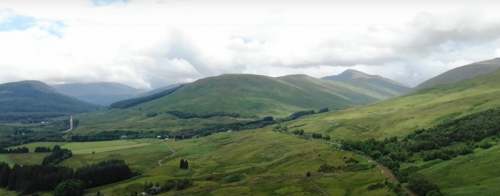Designed by an interdisciplinary team of scientific experts, and funded by SEFARI Gateway’s Responsive Opportunity Fund, our Google earth tours feature climate research from across SEFARI’s consortium of globally renowned institutes, namely Biomathematics and Statistics Scotland (BioSS), the James Hutton Institute, Moredun Research Institute, the Rowett Institute, Royal Botanic Garden Edinburgh (RBGE) and Scotland’s Rural College (SRUC) and other partners.
Here’s a quick preview of what you can expect:
- First off, we have the temperate rainforests on the Scottish west coast. These ecosystems support some unique species, especially epiphytic lichens (an organism that grows upon another plant or object for physical support). Scientists from RBGE are studying these lichens to create microclimates suitable to aid their survival and ensure the rainforests continue to support these distinct life forms.
Figure: An epiphytic lichen as seen on one of the trees in Scotland’s temperate rainforest
- Another research area in focus is the urban rain gardens, built to regulate water flow during extreme flooding events by using a bioretention system. This system captures excess rainfall in a below-ground basin and could provide an answer that helps urban communities combat the impacts of both flooding and drought caused by climate change.
- Next a team of scientists at SRUC’s Kirkton and Auchtertyre farms are using sensors to study the role played by restored peatlands in addressing climate change. Peatlands are wetlands containing soil that is rich in organic matter. Despite these ecosystems providing vital carbon sinks, 80% of Scotland’s peatlands are in a degraded state. The research is significant as Scotland has set targets to restore 250,000 ha of peatland to help achieve net-zero.
- You can also explore the impact of peatland restoration on greenhouse gas (GHG) emissions at the Forsinard Flows. Here five flux towers help researchers monitor GHG emissions. The peatland restoration work at Forsinard is carried out by RSPB Scotland and the GHG monitoring work is a Joint Consortium project between: James Hutton Institute, Environmental Research Institute-University of the Highlands and Islands, RSPB, University of Exeter, University of Glasgow and UKCEH. NatureScot Peatland Action have also been involved in funding the active restoration programme and some of the equipment used.
- Like peatlands, there are plants which sequester carbon and help to combat climate change. One such plant is hemp which is suited to Scotland’s climate and growing conditions. Hemp is a great source of nutrients and it helps to promote biodiversity and soil health. Take the Hemp Futures tour and learn more about this study designed by the Rowett Institute.
- Climate positive farming approaches that help to achieve net-zero targets while protecting biodiversity and ensuring farm business sustainability are equally important in addressing the climate crisis. You can visit the Climate-Positive Farming Initiative at the James Hutton Institute’s Glensaugh farm which is working on activities including ‘HydroGlen’, a proposed renewable hydrogen powered farming community project, that could be replicated on other farms.
- Or how about taking a tour of SRUC’s Green Cow Facility which uses respiration chambers to measure gas emissions from cattle and sheep? The facility is being used to develop measures to reduce methane production. Methane is an important GHG and is released by cattle, sheep, buffalo, goats, deer and camels as a by-product during digestion.
- Climate change will influence the spread of parasites, which are known to adapt to changing weather conditions and affect livestock health. You can find out more on this tour about the impact of climate change on helminths (worm-like parasites), and the Moredun Research Institute research, being undertaken to help protect farm animals.
- Finally, you will get an opportunity to immerse yourself in the multi-functional seascape at Aberdeen Bay and learn about people’s understanding and perceptions on how we can sustainably and effectively harness our environment. Scotland generated 71% of its electricity from wind in 2020, and research at the James Hutton Institute is investigating how renewable energy production will fare amidst land and sea changes, and beneficiaries’ expectations.
Figure: A view of the Aberdeen Bay
The Paris Agreement was a milestone in creating ambitious targets for countries to reduce emissions, but the world is realizing we must do even more. While we don’t yet know the outcome of COP26, we do know progress is being made and Scotland, including the research at SEFARI, is striving to contribute towards helping us to achieve net-zero.
A complete set of the tours can be found here.
Project Team: Lorna Cole, Lorna Dawson, Duncan Robertson, Rebekka Artz, David Miller, Carol-Anne Duthie, Alison Hester, Philip Skuce, Davy McCracken, Chris Ellis, Martine Borge and Wendy Russell.
Sadikchya Singh has helped with the writing of this blog. She is currently on work placement with SEFARI Gateway and is pursuing her MSc in Science Communication and Public Engagement at University of Edinburgh.
